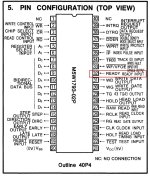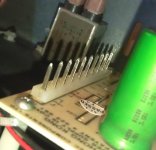k6whp
Experienced Member
- Joined
- Mar 1, 2014
- Messages
- 71
This just cropped up a couple of days ago and I am working my way through it. Situation is Kaypro 2X units. Unit #1 functions correctly, unit #2 does not. Unit #2 was function correctly and then failed as described below. Both have Epson SD-521 drives.
Symptoms:
(1) Boots O.k.
(2) A DIR command will display the A: drive contents.
(3) A -D (9-D.COM directory program) will not.
(4) A DIR B: command only results in the "DIR B:" command appearing on the screen, the B: drive lighting up and spinning but nothing further.
(5) Any other attempt to execute a program in the A: drive or the B: drive will result in similar results to #3 above.
Attempts to resolve the problem:
(1) Steps taken to determine problem by swapping components.
(A) Floppy cables swapped;
(B) Mother board swapped.
(C) FDDs (A: and B: FDDs) swapped. (Included resetting the jumpers and resistor plug as appropriate.)
(D) FDDs swapped in units -- A: for A;, B: for B:.
(E) All above resulted in Unit #1 failing as it did and Unit 2: behaving correctly.
(4) Measurements done.
(A) Both units showed +11.5 VDC at PS main board plug. Both showed little/no fluctuation on main board plug when above symptom tests done.
(B) Scope put on pin 6 of U43 (Z80 MCU) and measured 4.000 MHz as expected. No measurement done with symptom tests.
(C) Scope put on pin 24 of U44 (1793 FDD controller) and measured 1.000 MHz as expected. No measurement done with symptom test.
(D) Will measure clock stuff above during symptom tests. (Do not believed they will vary).
(E) When I figure out how to jury rig the FDD cable, power connector, will measure voltage, will measure same.
Conclusion so far.
It appears to NOT be mother board, FDD cable, power. Maybe the ROM chip? Both are (I think) 81-292s - I could swap them?. At this point I am just taking a W.A.G.
Wonder if anything occurs to anyone. Thanks in advance for suggestions and/or sharp eyes.
Symptoms:
(1) Boots O.k.
(2) A DIR command will display the A: drive contents.
(3) A -D (9-D.COM directory program) will not.
(4) A DIR B: command only results in the "DIR B:" command appearing on the screen, the B: drive lighting up and spinning but nothing further.
(5) Any other attempt to execute a program in the A: drive or the B: drive will result in similar results to #3 above.
Attempts to resolve the problem:
(1) Steps taken to determine problem by swapping components.
(A) Floppy cables swapped;
(B) Mother board swapped.
(C) FDDs (A: and B: FDDs) swapped. (Included resetting the jumpers and resistor plug as appropriate.)
(D) FDDs swapped in units -- A: for A;, B: for B:.
(E) All above resulted in Unit #1 failing as it did and Unit 2: behaving correctly.
(4) Measurements done.
(A) Both units showed +11.5 VDC at PS main board plug. Both showed little/no fluctuation on main board plug when above symptom tests done.
(B) Scope put on pin 6 of U43 (Z80 MCU) and measured 4.000 MHz as expected. No measurement done with symptom tests.
(C) Scope put on pin 24 of U44 (1793 FDD controller) and measured 1.000 MHz as expected. No measurement done with symptom test.
(D) Will measure clock stuff above during symptom tests. (Do not believed they will vary).
(E) When I figure out how to jury rig the FDD cable, power connector, will measure voltage, will measure same.
Conclusion so far.
It appears to NOT be mother board, FDD cable, power. Maybe the ROM chip? Both are (I think) 81-292s - I could swap them?. At this point I am just taking a W.A.G.
Wonder if anything occurs to anyone. Thanks in advance for suggestions and/or sharp eyes.




